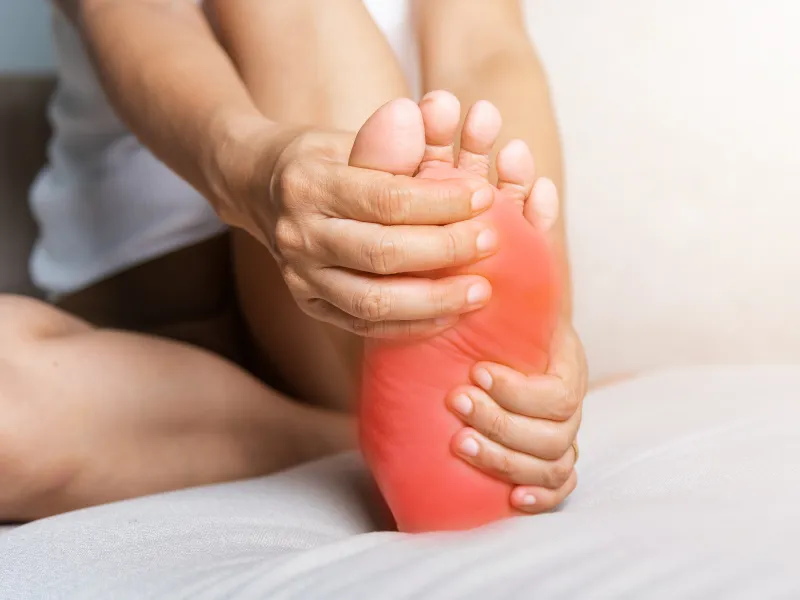The management of diabetic foot ulcers is a critical component in diabetic patient care due to their complexity and the severe complications that can arise if not treated promptly. Early detection and treatment of these ulcers are essential for preventing progression through various stages that could lead to severe consequences, including limb amputation.
What Is a Diabetic Foot Ulcer?
A diabetic foot ulcer is an open sore or wound that can occur in patients with diabetes, typically forming due to a combination of neuropathy, poor circulation, and trauma. These ulcers commonly occur on the toes, heel, or ball of the foot, areas subjected to pressure and friction.
In individuals with uncontrolled or long-term diabetes, the risk of developing these ulcers increases significantly, necessitating vigilant care and patient instructions for managing foot health.
What Are the 5 Stages of a Diabetic Foot Ulcer?
Stage 1: Pre-Ulceration / Redness and Skin Irritation
This early stage is characterized by initial symptoms such as redness, warmth, and swelling, often accompanied by calluses or blisters. Recognizing these early warning signs, like “red feet” or minor trauma, and performing daily foot inspections can prevent progression.
Stage 2: Superficial Ulceration
As the ulcer develops, an open sore becomes visible on the skin. This stage affects the skin layers without involving deeper tissues and often resembles a persistent sore or cracked callus.
Stage 3: Deep Ulcer Involving Tendons or Bone
At this stage, the ulcer penetrates deeper structures, such as fascia, muscle, or tendon. The risk of infection increases significantly, with potential signs of drainage or odor.
Stage 4: Localized Infection / Gangrene Onset
When dead tissue (necrosis) forms, accompanied by foul-smelling discharge and blackened skin, the condition may require surgical intervention such as debridement or amputation. Vayu Hyperbarics provides specialized care options for advanced ulcers.
Stage 5: Extensive Gangrene / Systemic Infection
In this severe stage, the infection may become life-threatening, necessitating urgent hospitalization and aggressive wound care.
Diabetic Foot Ulcer Healing Stages
Diabetic foot ulcer healing is a non-linear process and depends on factors such as blood sugar control, circulation, and infection control. The healing includes three phases:
- Inflammatory phase: The body’s initial response to wound, including cleansing.
- Proliferative phase: Involves granulation and epithelialization.
- Maturation phase: Final remodeling of tissue.
Proper offloading techniques, suitable wound dressings, and advanced treatments can accelerate healing significantly.
Early Signs of a Diabetic Foot Ulcer to Watch For
Detecting early signs is crucial. Look for:
- Redness or shiny skin
- Unusual blisters
- Minor cuts or bruises that don’t heal
- Changes in toenail color or texture
- Numbness or tingling
- Swelling without injury
Use a daily inspection checklist available in the VAYU Rack Card for comprehensive foot health monitoring.
Diabetic Foot Ulcer Treatment Options
- Conservative Wound Care
- Cleaning and debridement
- Offloading with special shoes or casts
- Moisture-control dressings
- Antibiotics for infections
- Blood sugar regulation
- Advanced Wound Healing Modalities
- Hyperbaric Oxygen Therapy (HBOT): Enhances oxygen delivery to tissue. Consent form available.
- Negative pressure wound therapy
- Growth factors or skin substitutes
When to See a Wound Specialist
Consult a specialist if:
- The wound doesn’t heal in 2 weeks
- Pain or numbness increases
- There are signs of infection (pus, odor, fever)
- There are changes in skin or toenail color
- Ulcer becomes deeper or starts bleeding
How to Prevent Diabetic Foot Ulcers
Prevention is vital and includes:
- Blood sugar control
- Daily foot care routine
- Proper footwear
- Avoid barefoot walking
- Annual foot exams
- Immediate treatment of minor injuries
Conclusion
Early recognition of diabetic foot ulcer stages can prevent severe complications. Proper wound care, pressure relief, and specialized treatments are essential for healing. Clinics offering hyperbaric wound therapy provide enhanced support, urging patients to act at the first sign of foot trouble to protect their mobility and health.
FAQs
Q. What does an early-stage diabetic foot ulcer look like?
A: Early-stage ulcers appear as red, irritated areas that may develop blisters.
Q. How long does it take for a diabetic ulcer to heal?
A: Healing time varies; early treatment can reduce healing to a few weeks.
Q. Can a diabetic ulcer heal on its own?
A: Without intervention, ulcers rarely heal due to diabetes complications.
Q. Is hyperbaric oxygen therapy effective for diabetic wounds?
A: Yes, HBOT can improve healing by enhancing oxygen supply to tissues.
Q. What’s the difference between a toe ulcer and leg ulcer in diabetics?
A: Toe ulcers are more common in those with neuropathy, while leg ulcers often relate to circulation issues.
For further information, refer to the Referral Form or consult with a specialist for advanced care strategies.

